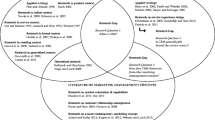Abstract
This study empirically explores a real-world manufacturer product development process from a service science perspective. In this era of keen global competition, the process of product development is crucial for companies before the final product is launched to the market. The poor development of a product can fail to meet customer needs and result in product failure, which can even lead to significant losses for manufacturers. However, traditional product development processes are much more manufacture-oriented rather than customer-involved. In this paper, we aim to use the Service science, management, and engineering (SSME) perspective, proposed by IBM, to improve product demand asymmetries by discovering true user requirements in order to enhance customer involvement and lead to better product development. We show how SSME is applied in the context of product development and in the discovery of customer needs, and propose a modified process based on SSME to the product development process.
















Similar content being viewed by others
References
Abe T (2005) What is service science. FRI Research Report 246
Anna S (2011) Service transition strategies of industrial manufacturers. Ind Mark Manage 40(5):683–690
Backman S, Veldkamp C (1995) Examining the relationship between service quality and user loyalty. J Park Recreat Adm 13:29–41
Baker DA, Crompton JL (2000) Quality, satisfaction and behavioral intentions. Ann Tour Res 27(3):785–804
Bitner M, Ostrom A et al (2008) Service blueprinting: a practical technique for service innovation. Calif Manag Rev 50(3):66–94
Boix R, De-Miguel-Molina B, Hervas JL (2012) Creative service business and regional performance: evidence for the European regions. Serv Bus. doi:10.1007/s11628-012-0165-7
Chang HH, Jeng DJF et al (2013) Conceptualising consumers’ word-of-mouth behaviour intention: evidence from a university education services in Malaysia. Serv Bus 7(1):17–35
Crevani L, Palm K et al (2011) Innovation management in service firms: a research agenda. Serv Bus 5(2):177–193
Flegal KM (2012) Obesity, overweight, hypertension, and high blood cholesterol: the importance of age. Obes Res 8(9):676–677
Forsman H (2011) Innovation capacity and innovation development in small enterprises. A comparison between the manufacturing and service sectors. Res Policy 40(5):739–750
French SA, Story M et al (2001) Environmental influences on eating and physical activity. Annu Rev Public Health 22:309–335
Gebauer H, Edvardsson B et al (2010) The impact of service orientation in corporate culture on business performance in manufacturing companies. J Serv Manag 21(2):237–259
Hartwig J (2008) Productivity growth in service industries: are the transatlantic differences measurement-driven? Rev Income Wealth 54(3):494–505
Hau LN, Thuy PN (2012) Impact of service personal values on service value and customer loyalty: a cross-service industry study. Serv Bus 6(2):137–155
Hidaka K (2006) Trends in services sciences in Japan and abroad. Q Rev 3(19):35–47
Hidaka K (2010) Service science, management, and engineering (SSME) in Japan. In: Handbook of Service Science. Springer, New York, p 707–715
IBISworld (2011) Gym, Health & Fitness Clubs in the US: Market Research Report
Jallat F (2004) Reframing business: when the map changes the landscape. Int J Serv Ind Manag 15(1):122–125
Ko YJ, Pastore DL (2004) Current issues and conceptualizations of service quality in the recreation sport industry. Sport Mark Q SMQ 13(3):159–166
Maglio P, Spohrer J (2008) Fundamentals of service science. J Acad Mark Sci 36(1):18–20
Maglio PP, Srinivasan S et al (2006) Service systems, service scientists, SSME, and innovation. Commun ACM 49(7):85
Maglio PP, Kieliszewski CA et al (2010) Handbook of service science. Springer, New York
McCain G, Tennyson SA et al (2004) Enhancing rural manufacturers competitiveness through design automation for new product development. J Bus Econ Res 2(9):81
Minguez J, Ruthardt F et al (2010) Service-based integration in event-driven manufacturing environments. Web Information Systems Engineering? WISE 2010 Workshops, Springer
Ounnar F, Pujo P (2012) Pull control for job shop: holonic manufacturing system approach using multicriteria decision-making. J Intell Manuf 23(1):141–153
Papadimitriou DA, Karteroliotis K (2009) The service quality expectations in private sport and fitness centers: a reexamination of the factor structure. Sport Mark Q SMQ 9(3):4–9
Saaty TL (1988) Decision making for leaders: the analytic hierarchy process for decisions in a complex world. RWS Publications, Pittsburgh
Saaty TL, Vargas LG (2012) Models, methods, concepts & applications of the analytic hierarchy process. Springer, New York
Schneider B, Bowen DE (2010) Winning the service game. In: Maglio PPP, Kieliszewski CAA, Spohrer JCC (eds) Handbook of service science. Springer, New York, pp 31–59
Schniederjans MJ, Wilson RL (1991) Using the analytic hierarchy process and goal programming for information system project selection. Info Manag 20(5):333–342
Shostack LG (1982) How to design a service. Eur J Mark 16(1):49–63
Spohrer JC, Gregory M, Ren G et al (2010) The Cambridge-IBM SSME White Paper Revisited. In: Handbook of service science. Springer, Heidelberg, pp 677–706
Thompson WR (2011) Worldwide survey of fitness trends for 2012. ACSM’s Health Fit J 15(6):9
Vargo SL, Lusch RF (2004) Evolving to a new dominant logic for marketing. J Mark 68:1–17
Vargo S, Maglio P et al (2008) On value and value co-creation: a service systems and service logic perspective. Eur Manag J 26(3):145–152
Voss C, Hsuan J (2011) Service science: the opportunity to re-think what we know about service design. In: The science of service systems. Springer, Berlin, pp 231–244
Xu X, Wang Z (2011) State of the art: business service and its impacts on manufacturing. J Intell Manuf 22(5):653–662
Yu THK, Willoughby M (2012) Innovations in service business. An introduction to the special issue from the Global Entrepreneurship and Services Conference, Taiwan, 2011. Serv Bus 6:405–409
Zeithaml VA, Bitner MJ et al (2009) Services marketing: integrating customer focus across the firm. McGraw-Hill Irwin, New York
Acknowledgments
The authors wish to express their appreciation to the anonymous reviewers for their constructive suggestions, which have helped us to improve the manuscript.
Author information
Authors and Affiliations
Corresponding author
Rights and permissions
About this article
Cite this article
Wu, LC., Shih, I. The product development process of an enterprise from an SSME perspective. Serv Bus 8, 29–50 (2014). https://doi.org/10.1007/s11628-013-0185-y
Received:
Accepted:
Published:
Issue Date:
DOI: https://doi.org/10.1007/s11628-013-0185-y




